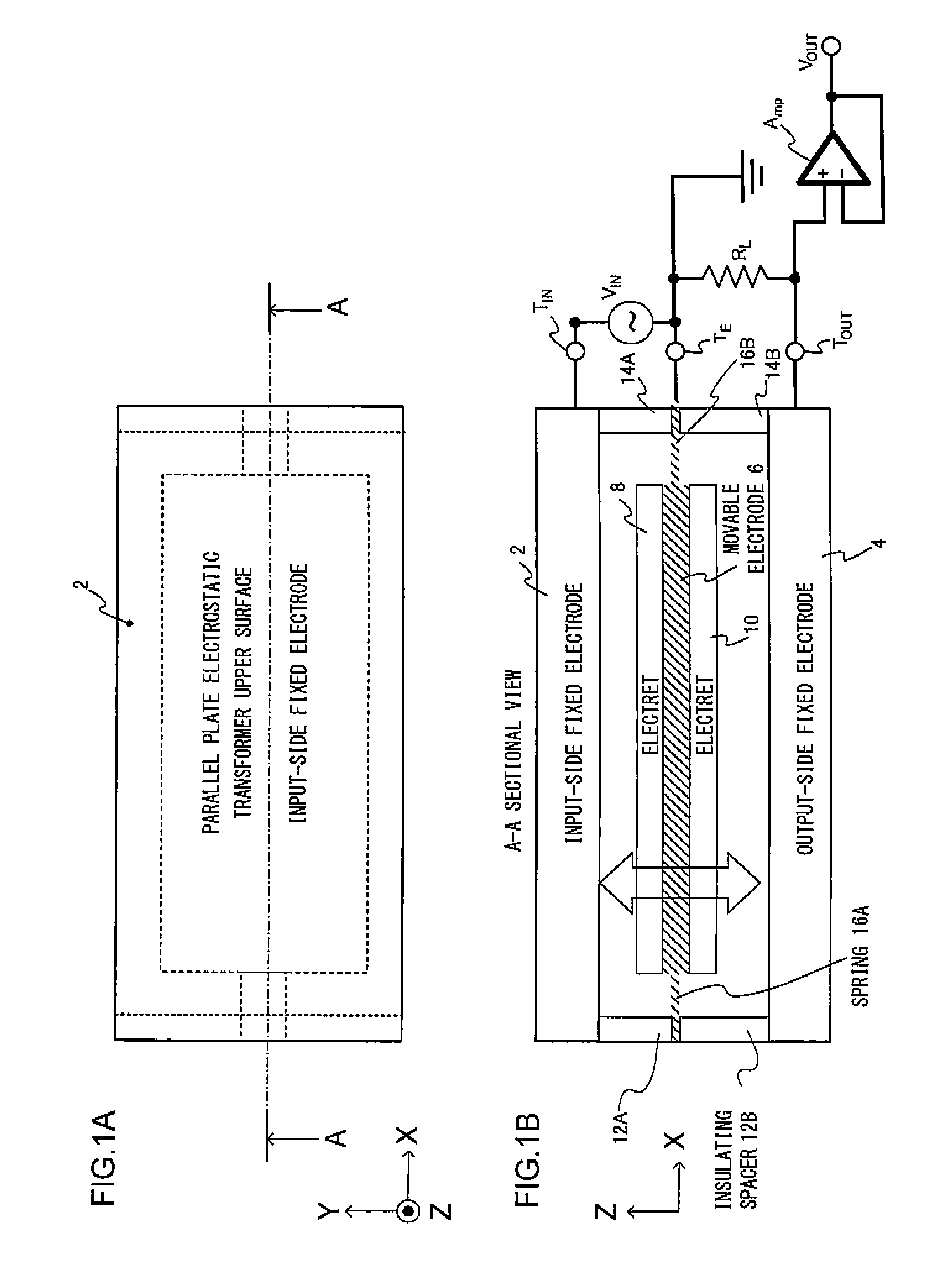Electrostatic Transformer
- Summary
- Abstract
- Description
- Claims
- Application Information
AI Technical Summary
Benefits of technology
Problems solved by technology
Method used
Image
Examples
embodiment 1
Variation 4 of Embodiment 1
[0054]FIGS. 6A and 6B show an electrostatic transformer achieved as variation 4 of embodiment 1 in a plan view (FIG. 6A) and a sectional view (FIG. 6B). The electrostatic transformer shown in the figures, achieved by modifying the electrostatic transformer described earlier in reference to FIGS. 1A and 1B, includes an internal insulating layer 18 (see FIG. 3B) disposed within the movable electrode so as to allow it to be used in a four-terminal transformer and further includes dielectric layers 50A and 50B each achieving a high dielectric constant, inserted therein so as to increase the electrostatic capacity.
[0055]By inserting the high dielectric constant layers 50A and 50B in the gaps, one present on the side where the input-side electrostatic actuator is located and another present on the side where the output-side electrostatic actuator is located, the electrostatic capacity can be increased as described above. For instance, the presence of dielectric ...
embodiment 2
Variation 1 of Embodiment 2
[0064]FIGS. 8A and 8B illustrate variation 1 of embodiment 2. FIG. 8A presents an enlargement of a projecting portion at the output-side fixed electrode 4C in FIG. 7B. Variation 1 of embodiment 2, to be described next, is distinguishable in that a plurality of comb teeth are formed at each projecting portion, as shown in FIG. 8B, at the output-side fixed electrode.
[0065]In variation 1 shown in FIG. 8B, a positional relationship identical to the positional relationship between the movable electrode 30 and the output-side fixed electrode 4B shown in FIG. 5B is adopted. Namely, as the movable electrode 6 shown in FIG. 7B vibrates along the lateral direction (i.e., along the X axis) the electric charge induced at the output-side fixed electrode 4C increases / decreases each time the electrets 70B each pass by a comb tooth portion, which allows the AC output voltage VOUT to assume a frequency higher than the frequency of the AC input voltage VIN. Namely, the elec...
embodiment 3
[0067]FIGS. 9A and 9B show an electrostatic transformer manufactured in embodiment 3, in a plan view (FIG. 9A) and a sectional view (FIG. 9B). The electrostatic transformer to be described next represents a type of electrostatic transformer adopting a structure that allows vibration both along the horizontal direction (i.e., along the X axis) and along the vertical direction. In the electrostatic transformer shown in FIGS. 1A and 1B, for instance, vibration occurs substantially along a single axis, namely in the up / down direction (i.e., along the Z axis), whereas in the electrostatic transformer shown in FIGS. 7A and 7B, vibration occurs only in the left / right direction (i.e., along the X axis). These electrostatic transformers each assume at least one resonance mode and each operate as an electrostatic transformer primarily by using the resonance frequency.
[0068]The electrostatic transformer in this embodiment, on the other hand, assumes two vibration modes, i.e., a vertical direct...
PUM
 Login to View More
Login to View More Abstract
Description
Claims
Application Information
 Login to View More
Login to View More - R&D
- Intellectual Property
- Life Sciences
- Materials
- Tech Scout
- Unparalleled Data Quality
- Higher Quality Content
- 60% Fewer Hallucinations
Browse by: Latest US Patents, China's latest patents, Technical Efficacy Thesaurus, Application Domain, Technology Topic, Popular Technical Reports.
© 2025 PatSnap. All rights reserved.Legal|Privacy policy|Modern Slavery Act Transparency Statement|Sitemap|About US| Contact US: help@patsnap.com



